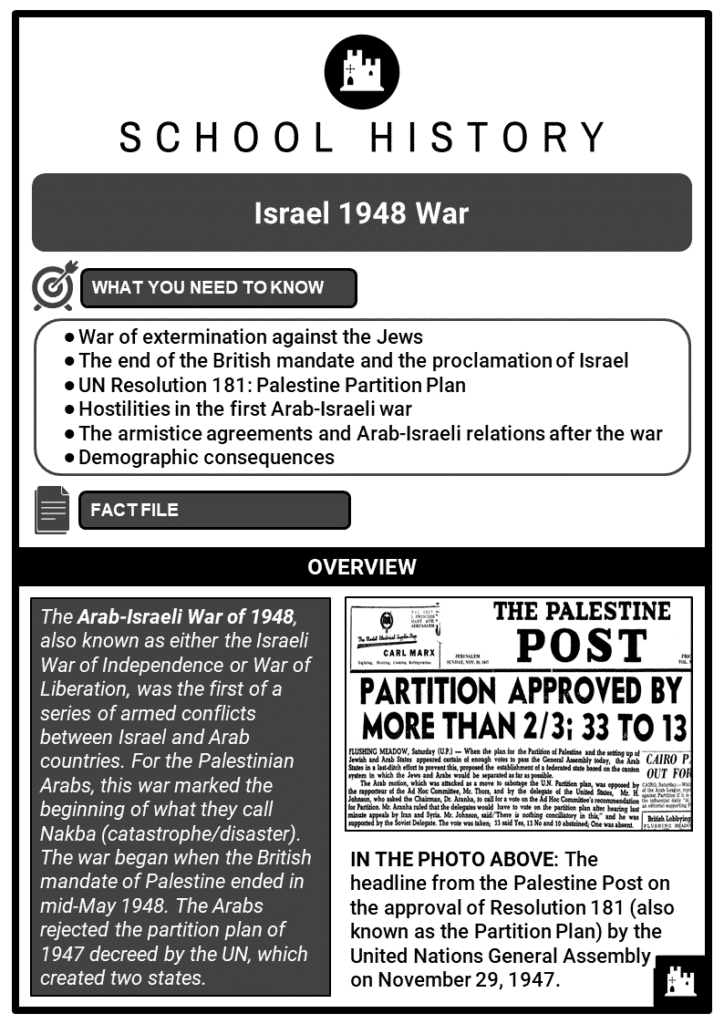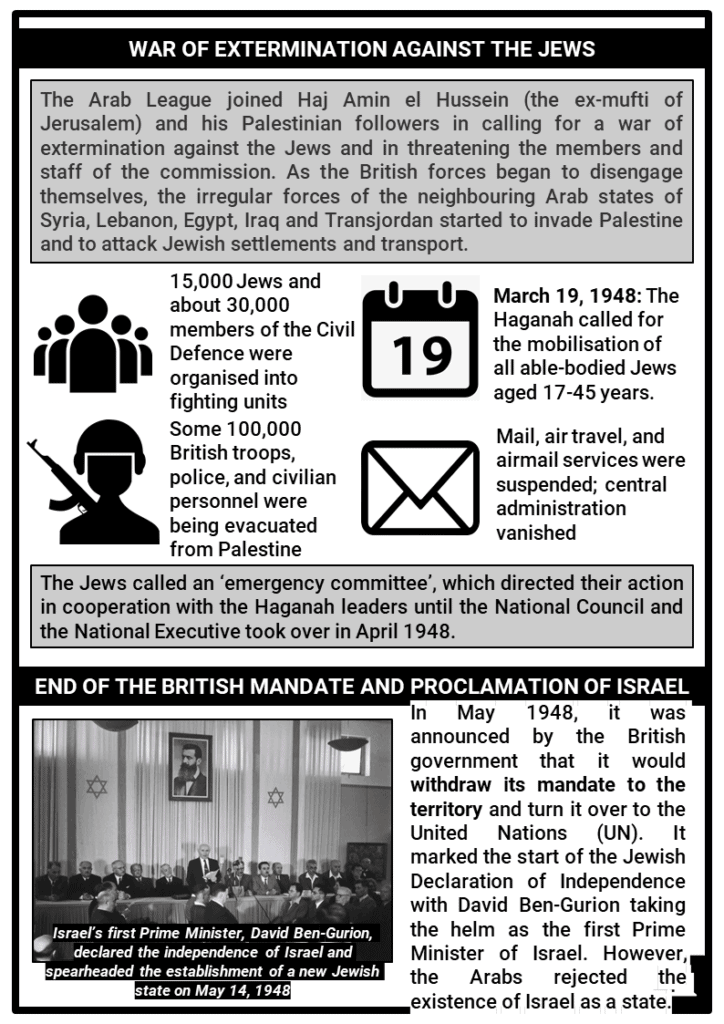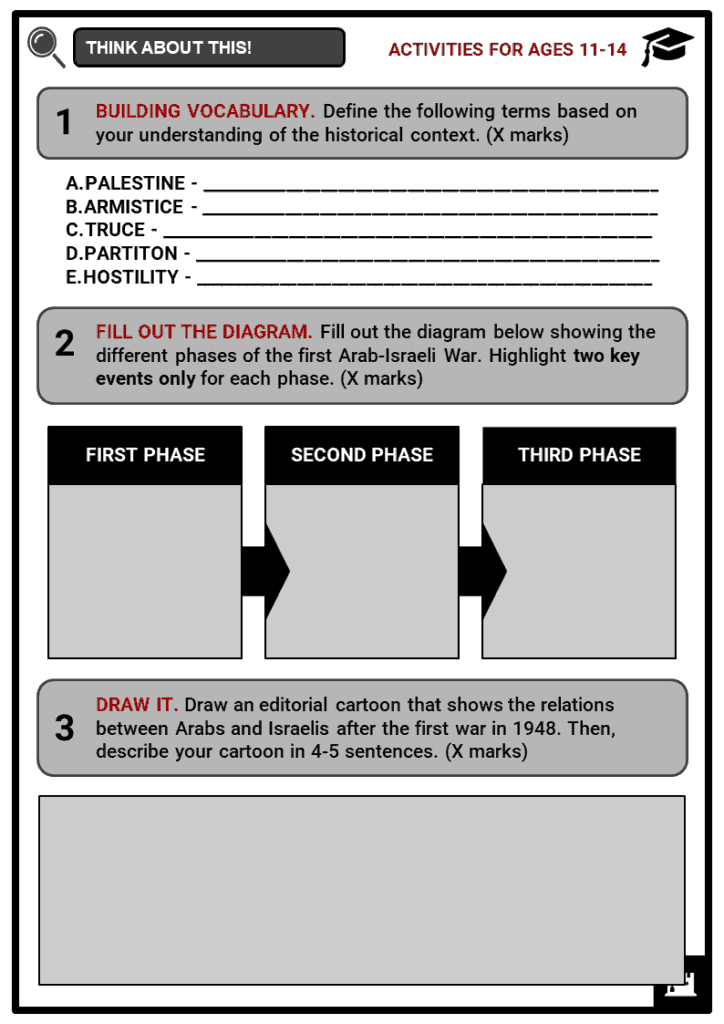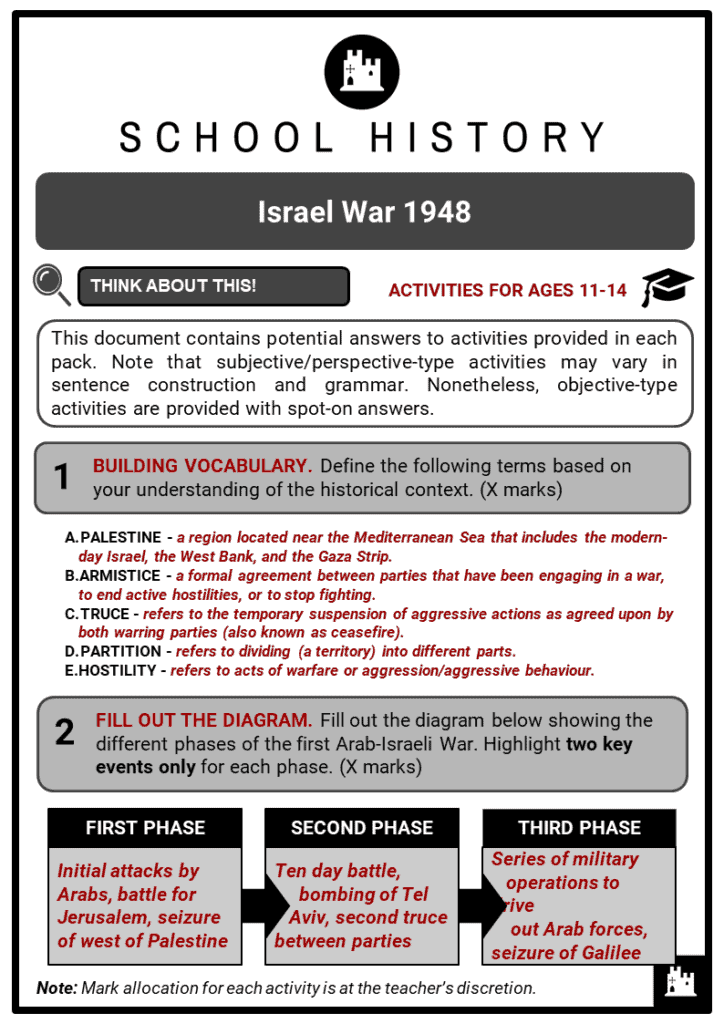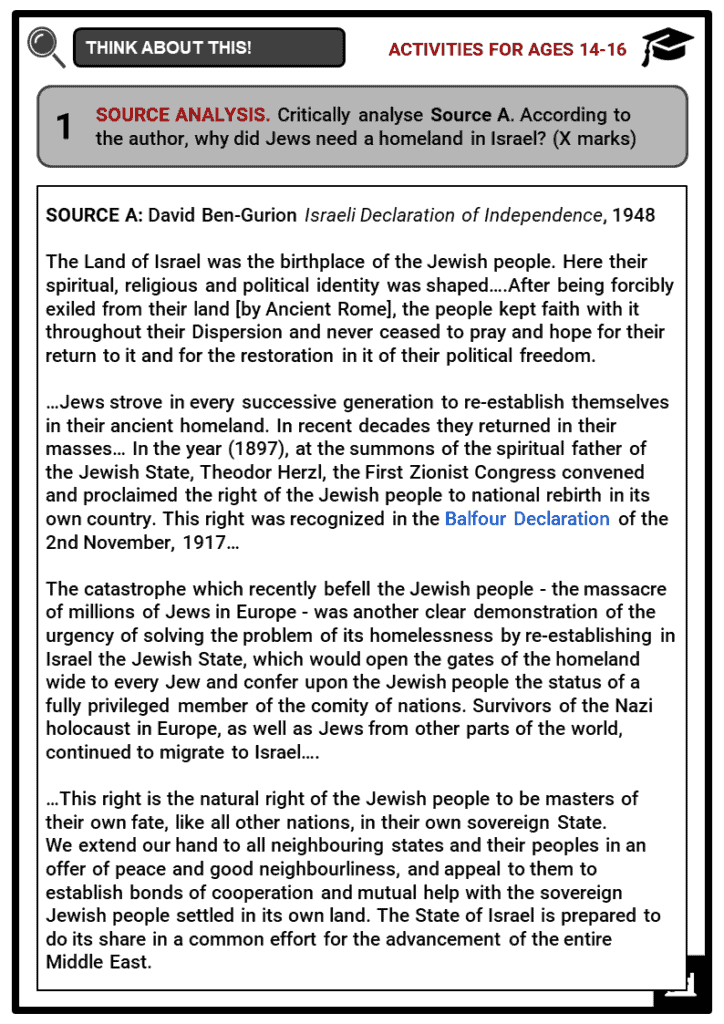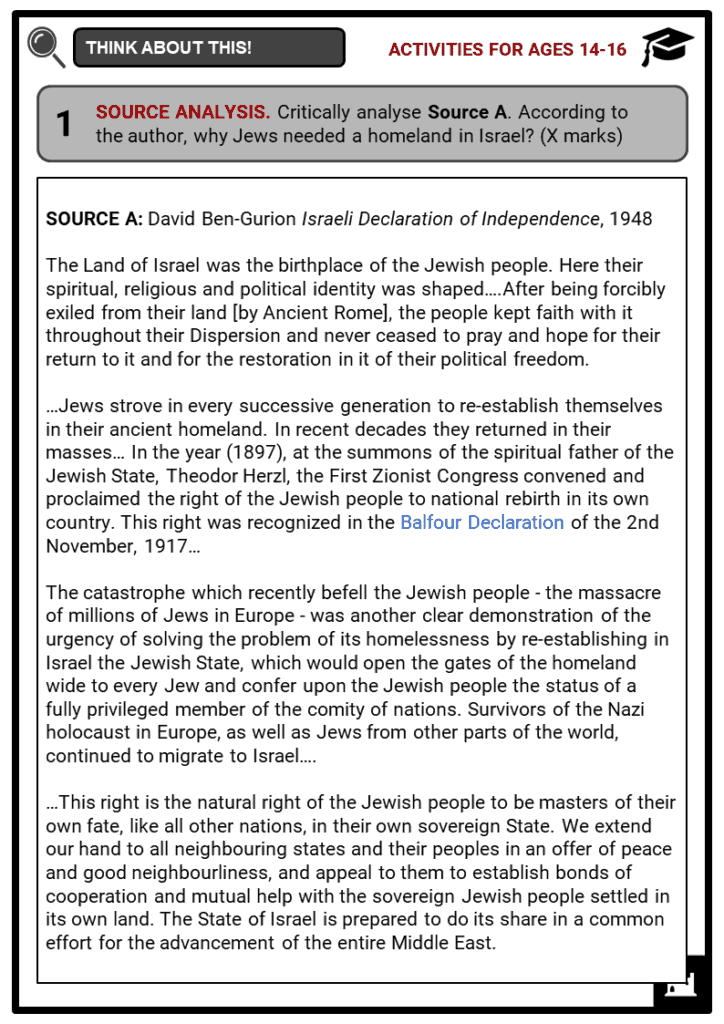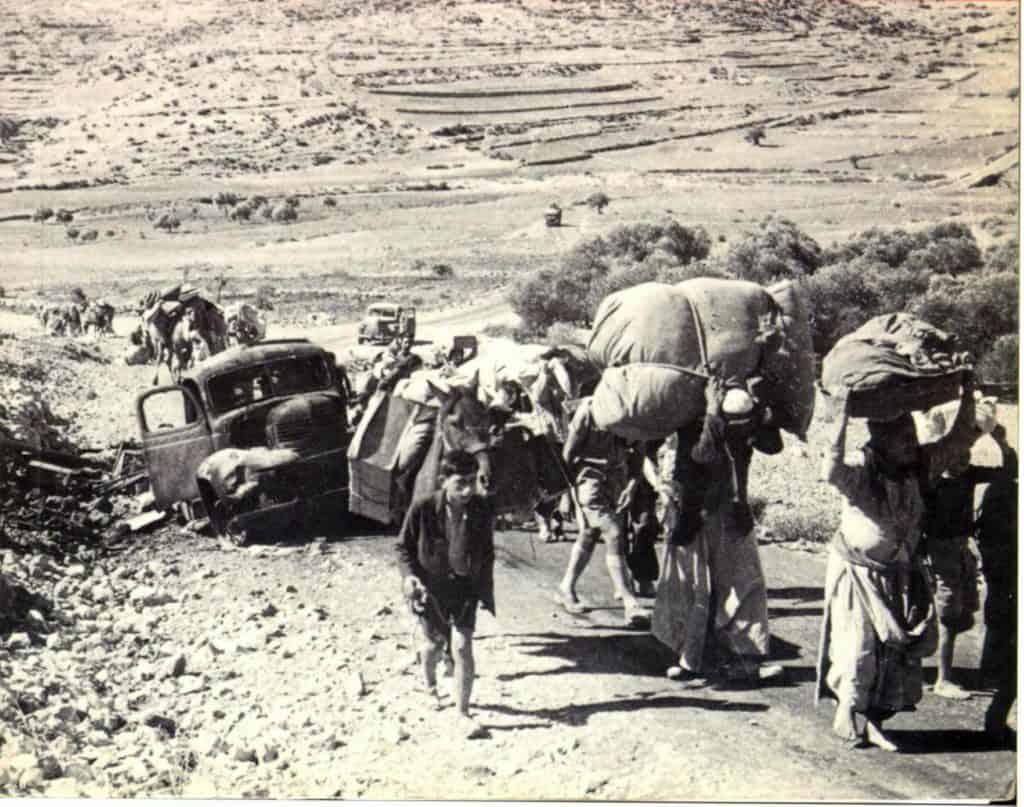Download Israel War 1948 Worksheets
Do you want to save dozens of hours in time? Get your evenings and weekends back? Be able to teach Israel War 1948 to your students?
Our worksheet bundle includes a fact file and printable worksheets and student activities. Perfect for both the classroom and homeschooling!
Table of Contents
Add a header to begin generating the table of contents
Summary
- War of extermination against the Jews
- The end of the British mandate and the proclamation of Israel
- UN Resolution 181: Palestine Partition Plan
- Hostilities in the first Arab-Israeli war
- The armistice agreements and Arab-Israeli relations after the war
- Demographic consequences
Key Facts And Information
Overview
- The Arab-Israeli War of 1948, also known as either the Israeli War of Independence or War of Liberation, was the first of a series of armed conflicts between Israel and Arab countries. For the Palestinian Arabs, this war marked the beginning of what they call Nakba (catastrophe/disaster). The war began when the British mandate of Palestine ended in mid-May 1948. The Arabs rejected the partition plan of 1947 decreed by the UN, which created two states.
War Of Extermination Against The Jews
- The Arab League joined Haj Amin el Hussein (the ex-mufti of Jerusalem) and his Palestinian followers in calling for a war of extermination against the Jews and in threatening the members and staff of the commission. As the British forces began to disengage themselves, the irregular forces of the neighbouring Arab states of Syria, Lebanon, Egypt, Iraq and Transjordan started to invade Palestine and to attack Jewish settlements and transport.
- 15,000 Jews and about 30,000 members of the Civil Defence were organised into fighting units
- Some 100,000 British troops, police, and civilian personnel were being evacuated from Palestine
- March 19, 1948: The Haganah called for the mobilisation of all able-bodied Jews aged 17-45 years.
- Mail, air travel, and airmail services were suspended; central administration vanished
- The Jews called an ‘emergency committee’, which directed their action in cooperation with the Haganah leaders until the National Council and the National Executive took over in April 1948.
End Of The British Mandate And Proclamation Of Israel
- In May 1948, it was announced by the British government that it would withdraw its mandate to the territory and turn it over to the United Nations (UN). It marked the start of the Jewish Declaration of Independence with David Ben-Gurion taking the helm as the first Prime Minister of Israel. However, the Arabs rejected the existence of Israel as a state.
UN Resolution 181: Palestine Partition Plan
- Following Britain’s withdrawal of the Palestine Mandate, the United Nations General Assembly created the UN Special Committee on Palestine (UNSCOP) to draw recommendations on the future of Palestine. The plan called for the partition of Palestine into Arab and Jewish states, with the Jerusalem-Bethlehem region as a separate entity to be governed by a special international regime.
- The Jews were satisfied with the first proposal but the Arabs were not. As a result, a new offer was made. Based on the proposal, only Jews who had arrived before the Balfour Declaration and their respective descendants would be considered as citizens of the new state. The Jews did not accept the plan.
- The Palestine Partition Plan based on the UNSCOP's modified report was submitted to the UN General Assembly and was voted upon on November 29, 1947. As the certainty of the passage of the resolution fell into question, pro-Jewish groups continued to intensify their lobbying. The resolution was passed by the assembly with 33 in favour, 13 against, and 10 abstentions.
- Following the proclamation of Jewish independence and the creation of Israel in 1948, the Palestinian Arabs began to invade Israel with the help of the neighbouring Arab states. This led to the outbreak of the first Arab-Israeli War.
Hostilities In The First Arab-Israeli War
- FIRST PHASE (MAY TO JUNE 1948)
- The Palestinian Arabs, together with Iraq, Egypt, Jordan, and Syria invaded Israel. In the southern portion of Palestine, an Egyptian army invaded and attacked Israeli settlements.
- The highlight of the first phase of the war was the battle for Jerusalem which saw Israel gaining much advantage over the Arabs. They were able to drive them off from their holdings.
- Israel was able to seize the western part of Palestine. A truce was declared by the UN on May 29, that came into effect on June 11 for 28 days. Both parties violated the ceasefire.
- SECOND PHASE (JULY 8-18, 1948)
- This was dubbed as the “ten-day battle”. General Muhammad Naguib and the Egyptian forces invaded and attacked Negba on July 8, 1948. Israeli forces initiated air attacks.
- Egyptian air forces bombed Tel Aviv in return. Meanwhile, the Haganah seized the Galilee region in northern Palestine, and temporarily opened the road to Jerusalem.
- In addition, they were able to resist attacks from Egypt. On July 18, the UN Security Council declared a second truce between both parties after a series of diplomatic talks.
- UN MEDIATOR’S PROPOSAL
- During the second truce, a proposal for a new Palestine partition plan was made by United Nations special mediator Count Folke Bernadotte. In the plan, Jerusalem would still be under the control of the UN as an international city. Also, the Negev region would be divided between Jordan and Egypt and there would be a Jewish state in the Galilee region.
- Palestinian refugees would be given an opportunity to return to Palestine. Jewish immigration would be regulated by the UN.
- Both Arabs and Israelis rejected the plan. The UN mediator was assassinated on September 17, 1948 by the militant Zionist group Lehi (the Stern Gang).
- THIRD PHASE (OCT 1948 TO MAR 1949)
- The final phase of the war involved Israeli forces conducting a series of military operations in an effort to drive out Arab forces, and in an attempt to secure the borders of Israel.
- At the end of October, the Israel Defence Forces (IDF) gained control of the entire Galilee region, had driven all Lebanese forces from Israel and occupied Lebanese villages.
- The operations continued from November to March. By the end of the war, Israel possessed an area that was greater than that initially partitioned by the United Nations.
The Armistice Agreements And Arab-Israeli Relations
- Ralph Bunche of the United Nations mediated the armistice agreements, which were signed successfully with Egypt (February 24, 1949), Lebanon (March 23, 1949), Jordan (April 3, 1949), and Syria (July 20, 1949).
- The UN General Assembly passed Resolution 194 on December 12, 1948 which created the UN Conciliation Commission that defined a peace settlement between Israel and the Arab states, and the return of Palestine refugees.
- However, its efforts proved to be futile. The United Nations Relief and Works Agency (UNRWA) for Palestinian refugees was created to alleviate the hardships of the war victims.
- ARAB-ISRAELI RELATIONS
- Arab-Israeli tensions constituted the major problem. Their relationship was a heavy strain on the nation’s resources and was responsible for the internal state of military preparedness and censorship. The outcome of the war also affected Israel’s relations with other nations interested in maintaining a balanced position regarding both sides.
- The Arab states’ international position of non- alignment allowed them to secure military and economic aid from both the East and the West. The United Arab Republic (U.A.R), which became the spearhead of the Arab anti-Israel position, benefited from Communist-bloc weapon aid.
- In 1956, Israeli’s determination to maintain their concept of military parity led to military actions against the U.A.R. forces in the Sinai Peninsula. Rapidly overcoming U.A.R. defences, Israeli troops advanced up to the Suez Canal. The international aspect of the Arab-Israeli conflict was reflected in early military involvement from Great Britain and France in the Sinai struggle, as well as in the diplomatic involvement of the United States and the Soviet Union. Border clashes also continued, especially with Syrian and Jordanian forces, and the military situation remained serious and explosive.
Demographic Consequences
- The first Arab-Israeli war caused Israel to lose about 5,800 people (500 of them were civilians and/or women). This represented 1% of Israel’s population. The war also caused 12,000 people to be seriously injured. It was one of the most bloody wars for Israel. On the Palestinian side, the number of victims has never been accurately counted.
- By the end of the war, the number of Palestinian deaths stood at about 20,000. On the other hand, in 1950, Egypt declared 1,400 dead and 3,700 disabled. There were several hundred deaths among the Jordanians, Iraqis, and Syrians, whereas the Lebanese only had a few dozen deaths.
- Demographically, the population of the region was profoundly altered.
- The conflict had caused the exodus of about 720,000 Palestinian Arabs out of the 900,000 who lived in what had become Israel. It also caused the exodus of all 10,000 Jews living outside these borders. The war and the foundation of Israel also triggered the massive exodus of Jews from Arab countries. In 1970, nearly 600,000 of them emigrated to Israel in order to form the Sephardic community of Israel. Some 150,000 Palestinians remained in Israel and were granted Israeli citizenship, though with differentiated rights (except for the Druze who were allied with the Israelis and thus were given equal rights). However, more than 35,000 people living along the borders were displaced or expelled after the war. Refugees on the other hand mainly settled in Transjordan, Gaza, Jordan, Lebanon, and Syria.
Image sources:
[1.] https://upload.wikimedia.org/wikipedia/commons/c/cd/Palestinian_refugees_1948.jpg

